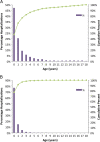Acute care utilization due to hospitalizations for pediatric lower respiratory tract infections in British Columbia, Canada
- PMID: 23217103
- PMCID: PMC3544629
- DOI: 10.1186/1472-6963-12-451
Acute care utilization due to hospitalizations for pediatric lower respiratory tract infections in British Columbia, Canada
Abstract
Background: Pediatric LRTI hospitalizations are a significant burden on patients, families, and healthcare systems. This study determined the burden of pediatric LRTIs on hospital settings in British Columbia and the benefits of prevention strategies as they relate to healthcare resource demand.
Methods: LRTI inpatient episodes for patients <19 years of age during 2008-2010 were extracted from the BC Discharge Abstract Database. The annual number of acute care beds required to treat pediatric LRTIs was estimated. Sub-analyses determined the burden due to infants <1 year of age and high-risk infants. Population projections were used to forecast LRTI hospitalizations and the effectiveness of public health initiatives to reduce the incidence of LRTIs to 2020 and 2030.
Results: During 2008-2010, LRTI as the primary diagnosis accounted for 32.0 and 75.9% hospitalizations for diseases of the respiratory system in children <19 years of age and infants <1 year of age, respectively. Infants <1 year of age accounted for 47 and 77% hospitalizations due to pediatric LRTIs and pediatric LRTI hospitalizations specifically due to respiratory syncytial virus (RSV), respectively. The average length of stay was 3.1 days for otherwise healthy infants <1 year of age and 9.1 days for high-risk infants (P <0.0001). 73.1% pediatric LRTI hospitalizations occurred between November and April. Over the study timeframe, 19.6 acute care beds were required on average to care for pediatric LRTIs which increased to 64.0 beds at the peak of LRTI hospitalizations. Increases in LRTI bed-days of 5.5 and 16.2% among <19 year olds by 2020 and 2030, respectively, were predicted. Implementation of appropriate prevention strategies could cause 307 and 338 less LRTI hospitalizations in <19 year olds in 2020 and 2030, respectively.
Conclusion: Pediatric LRTI hospitalizations require significant use of acute care infrastructure particularly between November and April. Population projections show the burden may increase in the next 20 years, but implementation of effective public health prevention strategies may contribute to reducing the acute care demand and to supporting efforts for overall pediatric healthcare sustainability.
Figures


Similar articles
-
Hospitalizations for severe lower respiratory tract infections.Pediatrics. 2014 Sep;134(3):546-54. doi: 10.1542/peds.2014-0244. Epub 2014 Aug 11. Pediatrics. 2014. PMID: 25113302
-
The clinical impact of multiple prevention strategies for respiratory syncytial virus infections in infants and high-risk toddlers in the United States.Vaccine. 2022 Oct 6;40(42):6064-6073. doi: 10.1016/j.vaccine.2022.08.011. Epub 2022 Sep 9. Vaccine. 2022. PMID: 36096968
-
RSV frequency in children below 2 years hospitalized for lower respiratory tract infections.Turk J Pediatr. 2013 Mar-Apr;55(2):130-9. Turk J Pediatr. 2013. PMID: 24192672
-
Systematic Literature Review of Respiratory Syncytial Virus Laboratory Testing Practices and Incidence in United States Infants and Children <5 Years of Age.J Infect Dis. 2022 Aug 15;226(Suppl 2):S213-S224. doi: 10.1093/infdis/jiac203. J Infect Dis. 2022. PMID: 35968874 Free PMC article.
-
Clinical relevance of prevention of respiratory syncytial virus lower respiratory tract infection in preterm infants born between 33 and 35 weeks gestational age.Eur J Clin Microbiol Infect Dis. 2008 Oct;27(10):891-9. doi: 10.1007/s10096-008-0520-8. Epub 2008 Jul 16. Eur J Clin Microbiol Infect Dis. 2008. PMID: 18629558 Review.
Cited by
-
The costs of suboptimal breastfeeding in Ontario, Canada, and potential healthcare resource impacts from improving rates: a pediatric health system costing analysis.Int Breastfeed J. 2025 Feb 22;20(1):9. doi: 10.1186/s13006-025-00702-y. Int Breastfeed J. 2025. PMID: 39987118 Free PMC article.
-
Hospital utilization rates for influenza and RSV: a novel approach and critical assessment.Popul Health Metr. 2021 Jun 14;19(1):31. doi: 10.1186/s12963-021-00252-5. Popul Health Metr. 2021. PMID: 34126993 Free PMC article.
-
Palivizumab's real-world effectiveness: a population-based study in Ontario, Canada, 1993-2017.Arch Dis Child. 2021 Feb;106(2):173-179. doi: 10.1136/archdischild-2020-319472. Epub 2020 Aug 28. Arch Dis Child. 2021. PMID: 32859612 Free PMC article.
-
Wildfire Seasons, Prenatal PM2.5 Exposure, and Respiratory Infections by Age 1 Year: A Population-Based Case-Control Analysis of Critical Developmental Windows.ACS EST Air. 2024 Oct 22;1(11):1483-1494. doi: 10.1021/acsestair.4c00213. eCollection 2024 Nov 8. ACS EST Air. 2024. PMID: 39539462 Free PMC article.
-
Defining the Epidemiology and Burden of Severe Respiratory Syncytial Virus Infection Among Infants and Children in Western Countries.Infect Dis Ther. 2016 Sep;5(3):271-98. doi: 10.1007/s40121-016-0123-0. Epub 2016 Aug 1. Infect Dis Ther. 2016. PMID: 27480325 Free PMC article. Review.
References
-
- Simoes EA, Carbonell-Estrany X. Impact of severe disease caused by respiratory syncytial virus in children living in developed countries. Pediatr Infect Dis J. 2003;22:S13–S20. - PubMed
-
- Langley JM, Wang EEL, Law BJ, Stephens D, Boucher FD, Dobson S, McDonald J, MacDonald NE, Mitchell I, Robinson JL. Economic evaluation of respiratory syncytial virus infection in Canadian children: a Pediatric Investigators Collaborative Network on Infections in Canada (PICNIC) study. J Pediatr. 1997;131:113–117. doi: 10.1016/S0022-3476(97)70133-1. - DOI - PubMed
-
- Shi N, Palmer L, Chu BC, Katkin JP, Hall CB, Masaquel AS, Mahadevia PJ. Association of RSV lower respiratory tract infection and subsequent healthcare use and costs: a Medicaid claims analysis in early-preterm, late-preterm, and full-term infants. J Med Econ. 2011;14(3):335–340. doi: 10.3111/13696998.2011.578188. - DOI - PubMed
-
- Law BJ, Carbonell-Estrany X, Simoes EA. An update on respiratory syncytial virus epidemiology: a developed country perspective. Respir Med. 2002;96(SB):S1–S7. - PubMed
Publication types
MeSH terms
LinkOut - more resources
Full Text Sources
Medical
Miscellaneous

